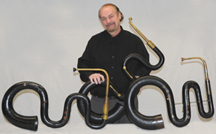

 ilitary
ilitary  erpent in C,
erpent in C,
England, unsigned, c. 1830
The Latham Serpent, c. 1830, was owned by Morton Latham (1843-1931) of Frensham, England, a composer, musicologist, and secretary of the London Bach Choir. The instrument, maintained by the Latham-Arkell family for many years, was restored by Christopher Monk in 1989. Christopher referred to the instrument as an “orchestral” serpent (due to its out-turned bell). As attested by members of the London Serpent Trio in 2005 when I purchased the horn from the Arkell family, the Latham serpent is one of the nicest playing military serpents and certainly the finest orchestral serpent in use today.
to download
a high density
image
Please include the following photo credit in any public presentation:
© Craig Kridel,
Berlioz Historical Brass


an outturned bell
DIMENSIONS
Measurements of air column with the instrument pitched at A=440
Sounding length: crook and body excluding mouthpiece: 2400 mm
Placement of keys/toneholes from the mouthpiece end:
1st key: 1010 mm
1st tonehole: 1140 mm
2nd tonehole: 1180 mm
3rd tonehole: 1220 mm
2nd key: 1390 mm
4th tonehole: 1550 mm
5th tonehole: 1594 mm
6th tonehole: 1640 mm
3rd key: 1800 mm

First key: left index finger (for B natural)

Second key: right pinky finger
External diameter at base of the instrument: 90 mm
Internal bell diameter at the end of the air column: 100 mm
Wall thickness at the end of the air column: 8 mm
Tonehole diameter
(surface opening; measurements do not take into account undercutting):
1st tonehole: 13 mm
2nd tonehole: 12 mm
3rd tonehole: 12 mm
4th tonehole: 12 mm
5th tonehole: 12 mm
6th tonehole: 12 mm

Third key: right thumb
Impressions of playing characteristics: The notes of the first octave are clear and center quickly in what, most likely, was the intent and the success of this design. My fingering decisions require that the third harmonic—second octave G—must be fingered as 1/2 and the second octave F must be vented with thumb key and 1/2/3. Players may wish to ascertain whether this same G fingering may be used on their church and military serpents. This pattern makes for very convenient second octave running notes. While music for this instrument is scored in the lower register, the instrument provides a very clear third octave sound with centered pitches.
Please include following photo credit in any public presentation:
photo courtesy of
Berlioz Historical Brass

For those individuals who wish to use images in commercial publications, copyright release will be freely granted; however, please contact the photographer
Craig Kridel; craigkridel@mindspring.com for a copyright release form.

“Please note that these photographs and measurements are given freely to members of the research community. I own the three instruments and maintain copyright and, officially, property rights of these images.” Craig Kridel, 2006
exploring the role of
early 19th century brass
Piccolo Press : ITEA Historical Instrument Section : The Tigers Shout Band : Harmoniemusik : Links